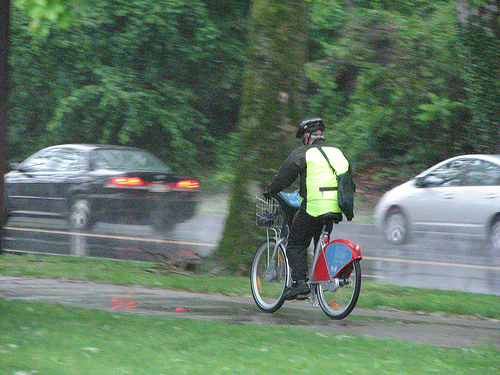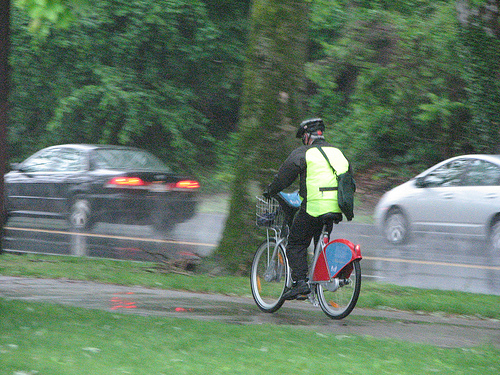 In Lyon, the Velo’v bike-share system has been a huge success.Photo: Kyle GradingerA couple of weeks ago, Elly Blue wrote here about the need for better data about bicycling here in the United States. In Lyon, France, the hugely popular Velo’v bike-share system is providing a source for at least some of types of bicycling numbers, having to do with travel times and routes.
In Lyon, the Velo’v bike-share system has been a huge success.Photo: Kyle GradingerA couple of weeks ago, Elly Blue wrote here about the need for better data about bicycling here in the United States. In Lyon, France, the hugely popular Velo’v bike-share system is providing a source for at least some of types of bicycling numbers, having to do with travel times and routes.
The Lyon study looked at 11.6 million trips taken on the city’s bikes between May 2005 and December 2007. It shows, among other things, that . From an item on the Physics arXiv Blog of MIT’s Technology Review:
Over an average trip, cyclists travel 2.49 km in 14.7 minutes, so their average speed is about 10 km/h. That compares well with the average car speed in inner cities across Europe.
During the rush hour, however, the average speed rises to almost 15 km/h, a speed which outstrips the average car speed. And that’s not including the time it takes to find a place to park, which is much easier for a Velo’v bike than a car.
Other results reveal the habits of the urban cyclist for the first time. For example, there is a clear peak in average speed at 7.45 am and 8.45 am on working days, when presumably there is rush to get to work. The average speed drops to a more leisurely 10 km/h at weekends….
The data also shows that bike journeys between two points are shorter in distance than the corresponding journey by car. There are no bike lanes in Lyon so this suggests that cyclists use other techniques to make short cuts, say [the researchers]. Their shocking conclusion is that cyclists often ride on the pavement, along bus lanes and the wrong way up one-way streets.
That kind of information will be useful for urban planners. For the first time they have real data to show where to build cycle lanes and how well they will be used.
Bike-share systems now up and running in Denver and Washington, D.C., could be a source for similar data. Let’s hope it’s made available to researchers.



